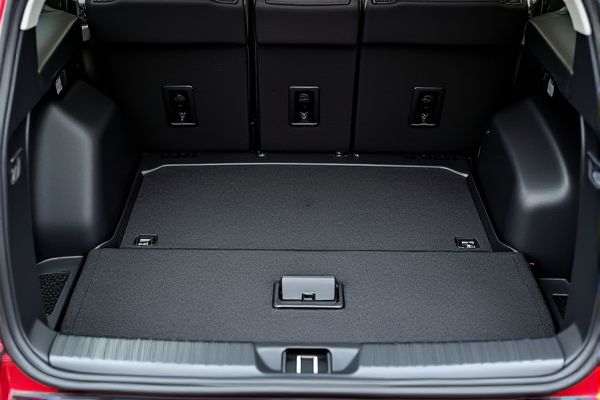
A boot scraper effectively removes mud and debris from your footwear, keeping floors cleaner, while a boot tray collects water and dirt, providing a designated spot to store wet or dirty boots. Discover which option best suits Your needs by exploring the detailed comparison in the rest of the article.
Table of Comparison
| Feature | Boot Scraper | Boot Tray |
|---|---|---|
| Purpose | Removes mud and debris from boot soles | Collects water and dirt from wet or muddy boots |
| Material | Metal or heavy-duty plastic with scraping edges | Plastic, rubber, or metal tray with raised edges |
| Location | Mounted near entry doors or on the ground | Placed indoors at entryways or mudrooms |
| Functionality | Physical scraping action to clean soles | Storage area to hold dirty boots and catch runoff |
| Maintenance | Occasional cleaning of scraper surface | Regular emptying and cleaning of collected debris |
| Use Case | Ideal for heavy mud or thick dirt removal | Suitable for wet, snowy, or muddy environments |
Introduction to Boot Scrapers and Boot Trays
Boot scrapers are metal or plastic devices designed to remove mud and dirt from boot soles before entering a building, enhancing cleanliness and safety. Boot trays serve as receptacles to hold wet or muddy boots, preventing debris and water from spreading on floors, often made from durable, waterproof materials. Both tools are essential for maintaining hygiene in homes and workplaces with heavy foot traffic in outdoor or muddy environments.
Purpose and Functionality of Boot Scrapers
Boot scrapers are designed to remove mud, dirt, and debris from footwear before entering a building, preventing indoor contamination and maintaining cleanliness. Unlike boot trays, which serve as stationary mats for placing shoes and collecting moisture, boot scrapers focus on active cleaning by scraping off particles from soles and sides of boots. This functionality is especially valuable in outdoor or muddy environments where thorough removal of debris is necessary for maintaining hygiene.
What Is a Boot Tray and How Does It Work?
A boot tray is a waterproof, molded plastic mat designed to hold and organize dirty, wet footwear while protecting your floors from mud, water, and debris. Unlike a boot scraper, which cleans the soles by scraping off dirt, a boot tray simply collects runoff and dirt particles, preventing messes inside your home or garage. Your shoes remain contained and dry, making boot trays essential for maintaining cleanliness in high-traffic entryways.
Key Differences: Boot Scraper vs Boot Tray
A boot scraper is a flat or curved metal tool designed to remove mud and debris from the soles of boots before entering a building, whereas a boot tray is a shallow container used to hold wet or dirty footwear, preventing mess on floors. Boot scrapers are typically mounted outside entrances for immediate cleaning, while boot trays are placed indoors to collect water and dirt from shoes after entry. The primary difference lies in function: scrapers clean boots actively, whereas trays contain and organize boots passively.
Benefits of Using a Boot Scraper
A boot scraper effectively removes dirt, mud, and debris from footwear, preventing indoor floors from becoming dirty and reducing cleaning efforts. Its sturdy design allows for thorough scraping in hard-to-reach shoe areas, making it ideal for outdoor use at entryways. Unlike boot trays, boot scrapers offer a more durable and low-maintenance solution for maintaining cleanliness during wet or muddy conditions.
Advantages of a Boot Tray in Your Home
A boot tray in your home offers superior protection by containing dirt, mud, and water directly from your footwear, preventing messes on your floors and carpets. Unlike a boot scraper, which primarily cleans mud off boots, a boot tray provides a waterproof barrier that helps maintain cleanliness and extends the life of floor surfaces. You benefit from easier maintenance and a more organized entryway, reducing wear and tear caused by outdoor elements.
Materials and Design Options for Boot Scrapers
Boot scrapers are commonly made from durable materials like cast iron, steel, and heavy-duty rubber to withstand outdoor elements and effectively remove mud and dirt. Design options range from simple flat plates with serrated edges to elaborate frames with bristles or metal bars, tailored to different levels of cleaning efficiency and aesthetic preferences. Customizable sizes and shapes allow boot scrapers to fit various entryway spaces and complement home exteriors while maximizing functionality.
Boot Trays: Styles and Material Choices
Boot trays come in various styles, including rectangular, oval, and compartmentalized designs, allowing you to organize and store footwear efficiently. Common materials include durable plastic, rubber, and heavy-duty metal, each offering water resistance and ease of cleaning to protect your floors from mud and moisture. Choosing the right boot tray material depends on your specific needs for durability, aesthetics, and environmental resistance.
Choosing the Right Option: Factors to Consider
When choosing between a boot scraper and a boot tray, consider the primary purpose: a boot scraper is designed to remove mud and debris from footwear, while a boot tray provides a designated space to store wet or dirty boots, protecting your floors. Your choice depends on the amount of outdoor activity and the level of cleanliness needed; boot scrapers are ideal for heavy-duty cleaning, whereas boot trays are better for organized storage and moisture containment. Evaluate the placement needs and material durability to ensure the option you select meets your home's practical and aesthetic requirements.
Boot Scraper vs Boot Tray: Which Is Best for You?
Boot scrapers effectively remove mud and debris from your footwear before entering, preserving indoor cleanliness. Boot trays provide a designated space that collects water, dirt, and mud, preventing messes on your floors and offering organized storage. Your choice depends on whether you prioritize immediate cleaning or containment of dirt and moisture in your entryway.
 homyna.com
homyna.com